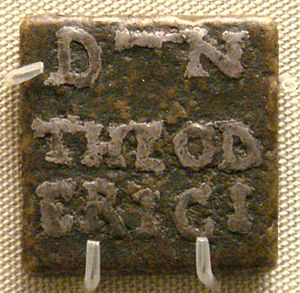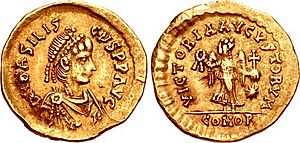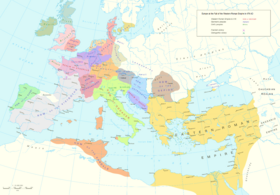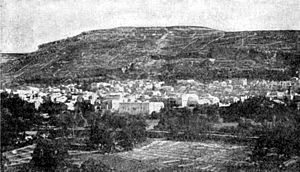Zeno (emperor) facts for kids
Quick facts for kids Zeno |
|
|---|---|

Semissis issued during Zeno's second reign
|
|
| Roman emperor of the East | |
| 1st reign | 29 January 474 – 9 January 475 |
| Predecessor | Leo II |
| Successor | Basiliscus |
| 2nd reign | August 476 – 9 April 491 |
| Successor | Anastasius I |
| Western emperors |
Julius Nepos (474–480) Romulus Augustulus (475–476) |
| Born | Tarasis c. 425 Rusumblada then Zenopolis, Isauria, Cilicia (now Elmayurdu, Karaman, Turkey) |
| Died | 9 April 491 (aged c. 65) Constantinople (now Istanbul, Turkey) |
| Spouse | Arcadia Ariadne |
| Issue |
|
| Dynasty | Leonid |
| Father | Kodisa |
| Mother | Lallis |
Zeno (around 425 – April 9, 491 AD) was an Eastern Roman emperor. He ruled from 474 to 475 and then again from 476 to 491. His time as emperor was full of challenges, including rebellions and disagreements about religion.
Despite these problems, Zeno managed to keep the Eastern Roman Empire stable. During his reign, the Western Roman Empire officially ended. Zeno is also known for trying to solve a major religious debate with a document called the Henotikon. This document aimed to bring different Christian groups together, but it was not very popular and was later stopped.
Zeno's Life and Rise to Power
Early Life and Family
Zeno's birth name was Tarasis. He was born in a region called Isauria, which is now part of Turkey. His father was Kodisa and his mother was Lallis. Tarasis had a brother named Longinus.
Tarasis first married a woman named Arcadia. They had a son named Zenon. Later, Tarasis changed his name to Zeno, a Greek name, to be more accepted in the Roman capital.
The Isaurians were people from the mountains of Anatolia. Even though they had been Roman subjects for a long time, Romans often saw them as outsiders. However, unlike some other groups, they were Orthodox Christians, which meant they could become emperor.
Becoming Part of the Imperial Family

In the 460s, Emperor Leo I wanted to reduce the power of Germanic generals in his army. He saw Zeno and his Isaurian soldiers as a good way to do this.
Zeno gained Leo I's trust by revealing secret letters. These letters showed that a powerful general's son, Ardabur, was plotting against the empire. Because of Zeno's loyalty, Leo I gave him an important position as commander of the imperial guards.
Marriage and Imperial Connections

To become even more accepted, Zeno married Ariadne in 466. She was the elder daughter of Emperor Leo I. Zeno's first wife, Arcadia, had likely passed away by this time.
The next year, Zeno and Ariadne had a son. They named him Leo, after the emperor. This was important because Leo I's only other son had died young, making Zeno's son the next in line for the throne.

Zeno continued to serve the empire as a military leader. He led campaigns in Thrace. During one campaign, there was a plot against him, but he escaped unharmed. This made Emperor Leo I trust Zeno even more.
Zeno was then appointed a top military commander in the East. He moved to Antioch and stayed there for two years. While in Antioch, Zeno became interested in the views of a religious group called the Monophysites.
In 471, Emperor Leo I had two powerful generals, Aspar and Ardabur, killed. Zeno and another general, Basiliscus, supported this. After this, Zeno returned to Constantinople and became a very important military commander.
Zeno's Time as Emperor
First Reign and Basiliscus's Revolt

In 473, Emperor Leo I made his grandson, Leo II (Zeno's son), a junior emperor. When Leo I died in January 474, Leo II became the main emperor. Since Leo II was only seven years old, his mother Ariadne and grandmother Verina convinced him to crown Zeno as co-emperor. This happened on January 29, 474. When Leo II sadly died later that year, Zeno became the sole emperor.
One of Zeno's first achievements was making peace with the Vandals. Their king, Genseric, had been attacking Roman coastal cities. Zeno sent an ambassador who successfully made a lasting peace treaty. This allowed Romans to pay for the release of prisoners and ended the Vandals' persecution of Orthodox Christians.
Despite this success, many people and the Senate did not like Zeno because of his Isaurian background. His claim to the throne came only from his marriage to Ariadne. Because of this, Zeno relied on his Isaurian generals, Illus and Trocundes.
In January 475, Zeno's mother-in-law, Verina, decided to overthrow him. She wanted her lover, Patricius, to be emperor. She got help from her brother, Basiliscus, and convinced other generals to join the plot.
Zeno was forced to flee Constantinople with his family and the imperial treasury. He hid in a fortress, but Illus, one of his generals who had joined the plot, besieged him. Illus even captured Zeno's brother, Longinus.
However, the people who overthrew Zeno soon started fighting among themselves. Basiliscus took the throne for himself and even had Verina's lover killed. He also allowed the killing of Isaurians in Constantinople, which angered Illus and Trocundes. Basiliscus also raised taxes and upset the Church.
Seeing this, Zeno secretly paid Illus to switch sides. Illus and his army joined Zeno, and they marched back to Constantinople. Zeno also managed to bribe another general, Armatus, who was supposed to stop him.
In August 476, Zeno returned to Constantinople. The Senate opened the city gates, and Zeno became emperor again. Basiliscus and his family tried to hide but were captured. Zeno promised not to shed their blood. Instead, he sent them to a fortress where they were locked in a dry cistern and died from exposure.
After getting his throne back, Zeno kept his promises to Armatus for a short time. But later, Zeno changed his mind and had Armatus killed.
End of the Western Roman Empire

In the Western Roman Empire, emperors were changing quickly. In 474, Zeno supported Julius Nepos as the new Western emperor. Nepos was on good terms with Zeno and even made coins with Zeno's name on them.
However, in August 475, while Zeno was dealing with Basiliscus's revolt, a Western general named Orestes rebelled. He forced Nepos to flee and made his own young son, Romulus Augustus, emperor.
One year later, in 476, a Germanic leader named Odoacer overthrew Romulus and Orestes. The Roman Senate then sent a message to Zeno. They asked Zeno to rule as the sole emperor of both the East and West. They also asked him to make Odoacer the official governor of Italy.
Zeno also received a message from Julius Nepos, who wanted help to get his throne back. Zeno told the Senate to welcome Nepos back. He also said that Odoacer should get his title from Nepos. In the end, Odoacer was recognized as ruler of Italy, but Nepos kept his title as Western emperor, even though he had no real power or army.
Odoacer ruled Italy in Nepos's name until Nepos died in 480. After Nepos's death, Odoacer took control of more territory. Zeno recognized Odoacer's power, and Odoacer recognized Zeno as the sole emperor of the reunited Roman Empire.
Marcian's Revolt (479)
Marcian was Zeno's brother-in-law, married to Ariadne's sister. In 479, Marcian tried to overthrow Zeno and become emperor himself. He gathered soldiers in Constantinople and attacked the imperial palace.
Zeno almost got caught by the rebels. However, during the night, Zeno's loyal general Illus brought in more soldiers and bribed some of Marcian's men. This allowed Zeno to escape. The next morning, Marcian realized he couldn't win and took refuge in a church, where he was arrested.
Zeno sent Marcian away, but Marcian tried to escape and rebel again. He was eventually defeated and captured by Illus's brother, Trocundes.
Illus's Revolt (484–488)
Illus, the general who had helped Zeno, became very powerful. Zeno grew suspicious of him and tried to get rid of him. Also, Verina, Zeno's mother-in-law, plotted against Illus.
Verina's plot failed, and Zeno, who was also wary of Verina, sent her away to a fortress. From her prison, Verina convinced her daughter Ariadne, Zeno's wife, to try and get her released. Ariadne asked Zeno, who sent her to Illus. Illus refused.
Ariadne then tried to have Illus killed, but the assassin only wounded him. The assassin was caught, and Zeno couldn't stop his execution.
Illus, along with his friends and brother, left the capital. They went to the East, where Illus was made a military commander. In 484, they started a rebellion, and Illus declared Leontius as the new emperor. Zeno sent an army against them, but Illus won. He captured Verina and convinced her to crown Leontius as emperor.
In 485, Zeno sent a new army. This army defeated the rebels and trapped them in a fortress. After a long siege of four years, the fortress was taken. Illus and Leontius were captured and executed in 488. Their heads were sent to Zeno.
Dealing with the Goths

Two powerful Ostrogothic leaders, Theoderic the Amal and Theodoric Strabo, were a constant threat to the empire. Zeno often tried to make them fight each other to keep them from attacking Constantinople. He sometimes offered them money and high military positions.
When Zeno's son Leo II died, Theodoric Strabo rebelled against Zeno. Strabo helped Basiliscus overthrow Zeno in 475. But when Zeno returned to power in 476, Strabo did not defend Basiliscus.
In 476-477, Zeno allied with Theoderic the Amal, Strabo's rival. Zeno ordered the Amal to attack Strabo. Zeno's plan was to have the two Goths weaken each other.
The two Theoderics eventually agreed to work together and asked Zeno for more land for their people. Zeno tried to bribe Theoderic the Amal, but he refused. Zeno's army had some success against the Goths, but Zeno didn't push his advantage. He allowed Theoderic the Amal to move west, plundering lands.
With Theoderic the Amal far away, Strabo made a deal with Zeno. Strabo got his wealth back and was given command of Roman troops. However, Strabo's large army was still a threat. Zeno convinced the Bulgars to attack Strabo's Goths. Strabo defeated the Bulgars and moved towards Constantinople, but he faced problems with his own men. He died in an accident in 481.
After Strabo died, Theoderic the Great became king of all the Ostrogoths. He continued to cause problems in the Balkan region. Zeno allied with Theoderic, making him a top general and even a consul in 484. This was a very high honor for a non-Roman. Zeno had Theoderic fight against Illus and the rebel Leontius.
However, in 486, Theoderic rebelled again and attacked Constantinople, cutting off its water supply. Zeno made peace with Theoderic. They agreed that the Ostrogoths should invade Italy and fight Odoacer, who had supported Leontius. This plan helped remove the Germanic presence from the Eastern Empire.
The Henotikon (482)
In religious matters, Zeno is known for his Henotikon, or "Act of Union," issued in 482. This document aimed to bring peace between two Christian groups: the Chalcedonians and the Miaphysites. The Chalcedonians believed Christ had two natures, while the Miaphysites believed he had one. The Council of Chalcedon (451) had condemned the Miaphysite view, but Miaphysites were still strong in the Eastern parts of the empire.
Zeno needed the support of these Eastern provinces. So, with the help of the Patriarch Acacius of Constantinople, Zeno issued the Henotikon. This document stated that the Nicene-Constantinopolitan Creed was the only true statement of faith. It condemned certain teachings but avoided directly mentioning the two natures of Christ.
The bishop of Rome, Pope Felix III, refused to accept the Henotikon. He even removed Acacius from the Church in 484. This started a major split, known as the Acacian schism, which lasted until 519.
In 489, Zeno closed a Persian Christian school in Mesopotamia because it was promoting certain teachings that were not accepted. He built a church in its place.
Samaritan Revolt (484)
According to Samaritan sources, Zeno persecuted the Samaritans. They say Zeno visited their city, Sichem, and asked their leaders to convert to Christianity. When they refused, many Samaritans were killed, and their synagogue was turned into a church. Zeno also took Mount Gerizim, a holy place for Samaritans, and built a tomb for his son there, placing a cross on it.
Later, in 484, the Samaritans revolted. They attacked Sichem, burning churches. They chose a leader named Justa as their king. They then moved to Caesarea, where they killed Christians and destroyed a church. Justa celebrated his victory with games. However, a Roman general defeated Justa, killed him, and sent his head to Zeno.
Modern historians believe that Zeno's actions against the Samaritans happened after the rebellion, around 489, as a punishment. Zeno rebuilt the destroyed churches, and Samaritans were banned from Mount Gerizim.
Death and Succession
Zeno died on April 9, 491, after ruling for 17 years. He had no sons to take his place, as Leo had died in 474 and his first son, Zenon, had died young.
Zeno's wife, Ariadne, then chose a favored member of the imperial court, Anastasius, to become the next emperor. Zeno's brother, Longinus, rebelled against this choice, starting a conflict known as the Isaurian War.
Some later stories say that Zeno was locked in a tomb while still alive, either unconscious from drinking too much or from a sudden illness. These stories claim he woke up and cried for help, but Ariadne had forbidden anyone to intervene. However, earlier historical sources do not mention this, and it is likely just a dramatic tale.
See also
 In Spanish: Zenón (emperador) para niños
In Spanish: Zenón (emperador) para niños




